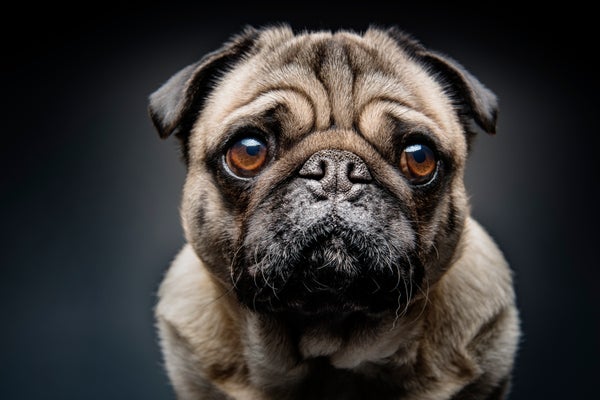In the celebrated Claymation series Wallace and Gromit, loyal dog Gromit is silent yet highly expressive, often making his thoughts known with pronounced eyebrow movements. Although they are exaggerated on the clay pup for comedic effect, any real dog’s owner will confirm these animals do seem to have highly communicative faces. A pooch’s raised eyebrows and tilted head suggest meaning to humans, and widened “puppy dog eyes” endear our pets to us. Researchers reported Monday in Proceedings of the National Academy of Sciences that our best animal friend’s facial anatomy may have evolved specifically for that purpose as a result of human selection.
The new study combined anatomical and behavioral experiments. The scientists first compared the facial anatomy of six domestic dogs, each representing a different breed, to that of four gray wolves (modern dogs’ closest living relatives) from two wild populations. They found that the muscles required to raise the inner eyebrows and widen the eyes are present in most dogs—but not in wolves, which have a small tendon instead. Next the researchers exposed nine wolves and 27 dogs to humans for two minutes, and observed the canines’ behavior. The dogs, but not the wolves, made the “highest intensity” eyebrow movements while in the humans’ presence. The researchers surmise that dogs gradually developed the anatomy underlying this communicative ability in response to human preference across tens of thousands of years.
Bridget Waller, an evolutionary psychologist at the University of Portsmouth in the U.K., and co-author of the study, says interspecies communication is an important evolutionary adaptation in some domesticated animals—largely because it has such a high priority among humans. “Communication is key to everything that we do with each other,” Waller says. When humans domesticated animals, “we shaped them into things that we can relate to and that are useful to our lives.” This process likely occurred both on conscious and unconscious levels. Humans actively selected for certain traits because they helped make animals more useful as laborers or food sources, Waller explains. Other attributes—such as more expressive faces—may have simply made animals more tolerable to humans so we were more likely to care for them, she says, “even if we were not intending to create a new behavior or new morphological trait.”
On supporting science journalism
If you're enjoying this article, consider supporting our award-winning journalism by subscribing. By purchasing a subscription you are helping to ensure the future of impactful stories about the discoveries and ideas shaping our world today.
Puppy dog eyes are apparently one such behavior: Waller and her colleagues previously reported that dogs make the endearing expression more often when humans are present. Domesticated animals frequently possess infantile features such as large foreheads or big, rounded eyes; these characteristics are thought to trigger the so-called cute response in humans. “We are innately predisposed to respond with a kind of nurturing behavior towards certain physical characteristics,” says James Serpell, an ethologist at the University of Pennsylvania who was not involved in the study. “Over time, [humans selected] for traits that satisfy that parental nurturing response.”
The facial musculature the researchers examined gives rise to the morphological, or structural, trait that allows dogs to irresistibly widen their eyes. Only one dog breed they looked at, the Siberian husky, lacked one of the two muscles associated with this behavior. Siberian huskies are an older breed and more closely related to wolves than are other dog breeds, most of which arose as recently as a few hundred—or at most, a few thousand—years ago. Richard Schneider, a developmental biologist at the University of California, San Francisco, who was not involved in the study, says this lack of eyebrow muscles in Siberian huskies may indicate that the relevant morphology in most dogs arose as a result of more recent selective breeding in other dog breeds, rather than through the earlier, spontaneous process of domestication. “There’s lots of evidence that once humans realized they had the power to breed animals, they could essentially breed for whatever kinds of traits they wanted,” Schneider says. “But that’s breeding, not domestication.”
It is also possible these features are a byproduct of self-selection for amiability among the earliest domesticated dogs, says Zsófia Virányi, an ethologist and cofounder of the Wolf Science Center at Veterinary University, Vienna, who was not involved in the study. “As these animals came closer and closer to human settlements, we certainly didn’t want them to be aggressive,” Virányi notes. “That means you needed animals that were pretty tractable.” Dogs may have adapted to be more submissive, she explains, and to show it via puppy dog eyes. If they “have this kind of deferential temperament, they may be more motivated to make this movement more often,” she says.
Serpell suggests studying dogs that do not interact with humans—such as feral dogs—to parse the degree to which the puppy dog eye gesture was selected for over thousands of years, or simply a learned behavior stemming from interactions with humans during the dogs’ own lifetimes. And Waller says it would also be “very useful” to look at foxes that have undergone domestication in experimental settings to see whether their facial anatomy has changed as well. “I think there are big questions,” she says,” about how domestication shapes behavior in all sorts of species.”
